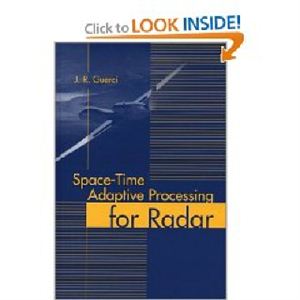The burgeoning popularity of space-time adaptive processing (STAP)
is easily
demonstrated with a quick keyword search. Although originally coined for
airboe multichannel moving target indicator (MTI) radar [1, 2], the acronym
has been adopted in many disciplines in which joint adaptive sensor temporal
and spatial processing are performed (e.g. , multidimensional adaptive filtering).
Although a widely published topic, there is a void in book-form coverage
at the introductory to intermediate level—a niche which this book is designed
to address.
Multichannel space-time array processing is an extremely rich topic
area in and of itself (see, for example, the recent authoritative text by H. L.
Van Trees [3]). When coupled with the mode marvel of a radar system,
it is doubtful that any single source could come close to providing comprehensive
coverage. In selecting both the scope and treatment for this book, I had
the benefit of having taught both introductory and advanced courses on
STAP for radar for several years in industry, academia, and the IEEE Radar
Conference series. The audience for such courses is extremely diverse, ranging
from pure theoretical academicians to working engineers trying to implement
STAP on time and on budget (and most occupation categories in between).
Moreover, such forums were generally quite time constrained, placing a
premium on efficient teaching methods.
J. R. Guerci
Artech House
Boston · London
www.artechhouse.com
demonstrated with a quick keyword search. Although originally coined for
airboe multichannel moving target indicator (MTI) radar [1, 2], the acronym
has been adopted in many disciplines in which joint adaptive sensor temporal
and spatial processing are performed (e.g. , multidimensional adaptive filtering).
Although a widely published topic, there is a void in book-form coverage
at the introductory to intermediate level—a niche which this book is designed
to address.
Multichannel space-time array processing is an extremely rich topic
area in and of itself (see, for example, the recent authoritative text by H. L.
Van Trees [3]). When coupled with the mode marvel of a radar system,
it is doubtful that any single source could come close to providing comprehensive
coverage. In selecting both the scope and treatment for this book, I had
the benefit of having taught both introductory and advanced courses on
STAP for radar for several years in industry, academia, and the IEEE Radar
Conference series. The audience for such courses is extremely diverse, ranging
from pure theoretical academicians to working engineers trying to implement
STAP on time and on budget (and most occupation categories in between).
Moreover, such forums were generally quite time constrained, placing a
premium on efficient teaching methods.
J. R. Guerci
Artech House
Boston · London
www.artechhouse.com

